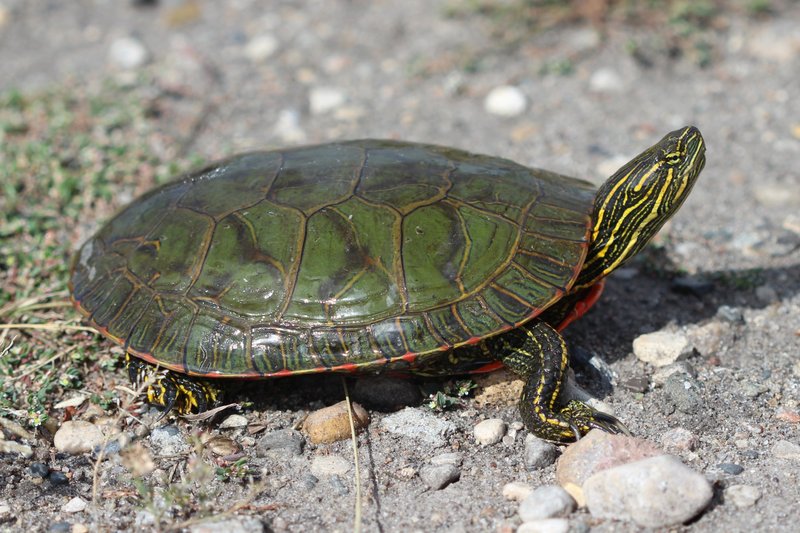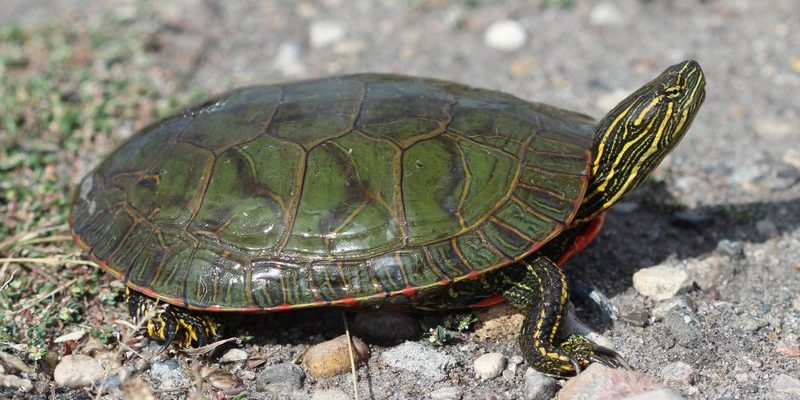
Let’s dive into what makes these turtles tick. Unlike other turtles, painted turtles have a unique way of coping with the challenges posed by their homes. Whether it’s dealing with freezing temperatures in winter or drying ponds in summer, painted turtles showcase remarkable adaptability. They make use of everything from their environment to their own biological features to ensure their survival. So, grab a cup of coffee and let’s explore the world of the painted turtle together!
Understanding the Painted Turtle’s Habitat
Painted turtles are quite the globetrotters when it comes to their habitats. You can find them in a wide range of freshwater environments across North America, from warm, sun-kissed ponds to lush marshes and slow-moving rivers. Their preferred spots often feature abundant vegetation because it provides food, cover, and basking sites. Imagine lounging in a leafy cabana; that’s what these turtles do to stay safe from predators.
Here’s the thing: painted turtles are highly adaptable. If their favorite pond dries up, they can migrate to nearby water sources. It’s like being in a tough situation at home and deciding to crash at a friend’s place until things get better. This flexibility is a key factor in their ability to survive harsh conditions. They have a keen sense for locating new habitats, often moving several miles if necessary.
Also, consider the temperature variations that painted turtles face. These creatures are ectothermic, meaning they rely on external heat sources to regulate their body temperature. In colder climates, you might spot them basking on rocks or logs to soak up the sun. This behavior is essential for their survival because it helps them stay active and find food. During winter, they can even hibernate at the bottom of ponds, where the water remains above freezing, ensuring they can ride out the cold months in safety.
The Painted Turtle’s Unique Adaptations
To thrive in various environments, painted turtles have developed some pretty clever adaptations. Their shells, for example, are not just for show. The colorful patterns on their shells not only make them visually stunning but also help with camouflage. When they’re resting among water lilies or mud, their bright designs blend in, keeping them safe from predators like birds and raccoons.
Their ability to hibernate is another fascinating adaptation. During the colder months, painted turtles will slow down their metabolism significantly. Instead of hunting for food, they enter a state of dormancy. This means that they can survive for months without eating. It’s a bit like hitting the snooze button on life when things get tough.
In the warmer seasons, turtles are more active. They have excellent sensory adaptations, too! Their keen eyesight helps them spot danger and food, while their sense of smell guides them to tasty plants and insects. Picture a master chef sniffing out the freshest ingredients—that’s basically how these turtles find their meals.
Nourishment and Diet
Speaking of food, let’s chat about what painted turtles eat and how they find it. They’re omnivores, which means they enjoy a mix of plant material, insects, and even small fish. Think of them as the perfect dinner guests who appreciate a well-rounded menu. During warmer months, their diet is diverse, mainly consisting of:
- Water plants
- Algae
- Snails
- Insects
Finding food is often a challenge, especially in harsher environments. Painted turtles have a few tricks up their sleeves. They tend to congregate in areas with warm, shallow waters that are rich in vegetation. This way, they can forage while also staying alert for predators. If food becomes scarce, they can even store fat in their bodies, which helps them survive tough times when resources are limited.
It’s fascinating to think about how these turtles have adapted their eating habits based on seasonal changes. In spring, when food is abundant after winter, they need to build up energy reserves. In fall, as temperatures drop, they focus on eating more to prepare for hibernation. It’s like getting ready for a long road trip by packing snacks—just smarter!
Behavior and Social Structure
When it comes to social behavior, painted turtles are pretty interesting too. They’re not exactly social butterflies, but they do enjoy hanging out in groups, especially during basking sessions. You’ll often see them piled up on a log, soaking up the sun together. While this behavior looks cute, it’s also a clever survival tactic. By basking in groups, they can keep an eye out for potential threats.
Painted turtles communicate through various behaviors. A simple movement of their head or the sound they make when swimming can say a lot. While they’re not chatty like parrots, their body language helps them interact with one another. Imagine a group of friends sharing glances and nods to understand each other—this is how they bond and establish territory.
When a painted turtle feels threatened, it won’t just sit still. They have a remarkable ability to retreat into their shells, which serve as a protective barrier. This instinct is crucial for their survival. Predators may think twice before trying to snack on a turtle that can quickly disappear into its armored shell.
The Impact of Climate Change on Painted Turtles
Unfortunately, painted turtles, like many creatures, face challenges from climate change. Changing temperatures can affect their habitat, food availability, and even their hibernation cycles. For instance, if temperatures rise too quickly, their hibernation patterns might be disrupted, leaving them vulnerable during both winter and summer months.
Additionally, rising water temperatures can lead to lower oxygen levels in ponds, making it difficult for painted turtles to thrive. Like many ecological puzzles, all these pieces are connected. If one piece falters, it can have a ripple effect throughout their habitat.
Conservation efforts are crucial to help maintain the delicate balance in their environments. Protecting wetlands and ensuring clean water are vital steps in safeguarding the painted turtle population. Think of it as creating a sanctuary for our colorful little friends, allowing them to continue thriving despite the odds stacked against them.
The painted turtle is more than just a pretty face; it’s a resilient survivor. With its incredible adaptability, unique adaptations, and behavioral strategies, it manages to thrive in some of the harshest environments. These turtles show us that even the simplest creatures can teach us powerful lessons about resilience and resourcefulness.
As we enjoy the beauty of these turtles basking by the water’s edge, they remind us of the delicate balance of nature and the importance of protecting their habitats. So next time you see a painted turtle, take a moment to appreciate how far they’ve come and their remarkable ability to survive in a world that sometimes throws challenges their way.

